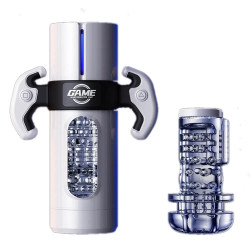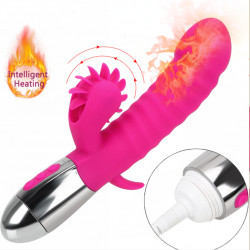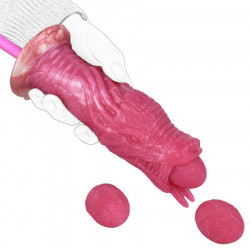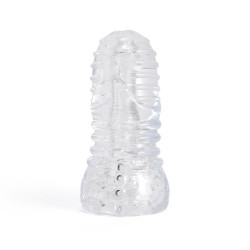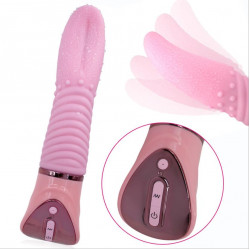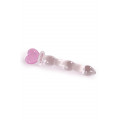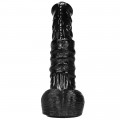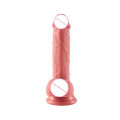Dildo Material Guide
Dildos are available in a wide variety of forms, sizes, and styles, as anybody who has spent enough time on our site knows, but what about the various materials? With so many options, it can be challenging to choose the best one for you if you lack specialized knowledge.
Although choosing the best dildo material is a matter of personal preference for most people, we've included the most popular varieties below along with an explanation to help you get started.
PVC
One of the earliest materials used in contemporary sex toys is PVC. Because of its great versatility, it can be found in fetish wear apparel, vibrators, butt plugs, and dildos. PVC has always been popular because it can be used to make dildos with different levels of stiffness. The adult industry has worked hard over the past ten years to replace phthalates with other softeners that give the dildo that sort of lifelike feeling, despite the fact that you will read a lot of articles online warning you against using PVC sex toys because they may contain phthalates (which we will discuss more later). We will always exclusively provide PVC dildos that are phthalate-free due to EU law REACH.
LATEX
Trees can yield latex, a naturally occurring liquid that is utilized in manufacturing to create a variety of products. Condoms, fetish clothing, and latex clothing may be known to you. Although they're not as popular these days, dildos are also made from latex.
Make sure you don't have any latex allergies before using a latex dildo. It is still a widespread issue that causes rashes and blisters in certain people, even though we know they are perfectly harmless for the body. Stop using the latex dildo or any other latex sex toy right away and get medical help if you start to feel uncomfortable.
TPE/TPR (THERMOPLASTIC ELASTOMER OR THERMOPLASTIC RUBBER)
TPE/TPR dildos are undoubtedly among the greatest dildo materials available; they are incredibly flexible, lifelike, and comfortable. Since they don't need any softeners or phthalates to feel authentic, they are totally harmless for the body. This material is used to make most of our dildos. It also has the benefit of being reasonably priced, so you can purchase incredibly lifelike dildos for a very small sum.
ABS
This is a rigid plastic that is hardly flexible at all. It works well for striking particular locations, such a g-spot or p-spot, that other toys might find difficult to reach. ABS plastic sex toys are made of durable material that is absolutely safe for the body and will not break easily. Additionally, they are quite simple to clean with warm, soapy water.
SILICONE
Most people agree that silicone is the best material for sex toys. Since dildos can be made with just 10% silicone and yet be referred to as silicone dildos, medical-grade silicone technically deserves this position. At least 70% or more silicone must be used in medical-grade silicone dildos.
In any case, these toys are incredibly soft and opulent, but the cost of the material will also increase. They are sleek, silky, and incredibly comfortable to use, making them ideal for the majority of sex toys.
Furthermore, because silicone dildos are entirely nonporous and incredibly simple to clean with warm, soapy water, they are incredibly safe for the body. After cleaning, let it air dry.
PU-COATING
The process of applying liquid polyurethane (PU) to a dildo's base is known as polyurethane coating, or PU-Coating. Typically, the dildo base is composed of a stiff substance like ABS. The toy is softer and more comfortable to use thanks to its PU coating.
GLASS
The majority of glass dildos are composed of borosilicate glass, a very durable and shatterproof substance that works well for Pyrex jugs, butt plugs, and dildos! Because borosilicate glass is difficult to break, sex toys constructed of this material are safe. It is possible, for instance, that if you drop it onto a hard surface from a height, it won't shatter; instead, big pieces will break off. Never try to use your glass dildo again if this occurs.
However, this is extremely uncommon, and glass dildos are usually among the most durable sex toys you will ever purchase. They're fun to look at, simple to clean and lubricate, and you can even use them to play with temperature by heating or chilling them.
METAL
Metal dildos are hefty, robust, and unyielding, which is very easy to comprehend. A metal dildo won't comply with your requests. They are among the simplest dildo materials to clean, and you won't experience any issues with their degradation over time. Life is a metal dildo!
WOOD
You can buy wooden dildos, albeit they are quite hard to find. Since they are difficult to mass make, these will often cost a little more, but if you would rather have something more customized, these might be for you. Because they are meticulously smoothed and then coated to make them nonporous, you won't have to worry about any splinters. Because they are nonporous—that is, no bacteria can develop on them if they aren't cleaning—they are quite safe to use. Even so, you should still clean all of the dildos after using them. These are likewise simple to use, clean, and reuse.
CERAMIC
Ceramic dildos, also known as bespoke hand-crafted pottery dildos, are quite uncommon, but they are available for purchase! Due to their current lack of mass production, expect to spend extra for this material. You must take care not to drop a ceramic dildo because they are heavier than regular ones. Because of their smooth texture, they will glide easily during penetration and are extremely stiff but easily lubricated.
NOTE: PHTHALATES
Phthalates were frequently used in dildos to make them softer and more realistic when sex toys were initially mass-produced. As more research and time passed, it became evident that phthalates were unsafe to use in many items, and as a result, their usage in manufacturing was outlawed.
Manufacturers of sex toys have discovered substitute softeners in the past ten years that provide the same realistic sensation while protecting the toy body.
STORAGE
It's simple to forget how to store your sex toys properly. We recognize that shopping for and buying your new dildo is a whole experience, followed by the thrill of receiving it and, of course, the culmination of using it! After everything is finished, you should wash your dildo in warm, soapy water and let it air dry.
However, what comes next?
You want to prevent damage or breakage to your new favorite toy, don't you?
You should make sure that each of your sex toys is kept apart, ideally in a storage bag. Since this may cause the materials to react, they should definitely not be left in contact with one another. Not cool! To ensure optimal results, keep each dildo individually in a dark, dry, and cool place so you can use them whenever you feel the need to.
Body-Safe Sex Toys: How to Choose Body-Safe Materials
For a very long time, sex toys have existed. An ancient stone dildo that is up to 30,000 years old was discovered in 2005 by some German experts. We are unable to determine if it was utilized for partner play or masturbation. And there are arguments for and against the idea that a stone dong is truly" body-safe."""
We do know that using sex toys to increase sexual pleasure is still a great idea. However, great pleasure comes with tremendous responsibility, and finding body-safe goods is crucial to enjoying your time with your boyfriend.
Less Stigma, More Sex Toys
Although sex toys have been around for a while, they have indeed taken off in the past ten years. The use of sexual wellness products is becoming more widespread despite the fights against censorship and a culture that continues to struggle with its relationship with sex.
The sexual empowerment revolution has been spearheaded by the emergence of sex-positive brands and sex tech, which has brought sex toys out of the shadowy backrooms and into the open. Both the quality of sex toys and the people who offer them have significantly improved. Additionally, sex toy sales have skyrocketed over the past two years due to the pandemic lockdowns; even though we may finally walk outside, this trend is not slowing down.
The stigma associated with using sex toys is gradually fading as we continue to discuss it, share our positive experiences with friends and lovers, and use the technology at our disposal to explore our bodies. Possessing pleasure is the new standard.
Not All Sex Toys Are Made Equal
Even with its increased legitimacy and widespread popularity, shopping for sex toys still has some risks. Some toys aren't safe for the purposes for which they were designed. Either non-toxic or poisonous. Either permeable or not. Body-safe and of medical quality. These terms are frequently used to promote sex toys.
Because of the nature of these goods, we should be cautious and knowledgeable about what we are putting into our most delicate areas. Knowing how to identify which O-inducing goods are the safest to use can have a significant impact on your well-being, regardless of whether you're buying sex toys for the first time or want to learn more about the ones you already have in your drawer.
What does "body-safe" really mean?
"Body-safe" is probably something you've seen flashing about in any sex toy store in recent years. And with good cause. You should use these products within and around your most sensitive regions. It's crucial to make educated decisions about what you eat and wear, just like you do with your food and cosmetics.
The issue with the sex toy market is that the FDA does not currently regulate it. This implies that the term "body-safe" has no set definition and does not provide any assurance that the product you are purchasing is safe to use on or in your body. Reputable vendors of sex toys want to set themselves apart from dishonest dildo vendors who prey on the current lawlessness in the market.
We accomplish this by locating, producing, and marketing goods made of non-toxic, health-safe materials and components. We value your physical well-being just as much as your enjoyment. When purchasing sex toys, one should be certain that they are not body-safe. Because of this, every product in Bellesa's Boutique is entirely safe for the body and non-toxic.
What are Phthalates and Why Do They Matter?
Phthalates are a class of compounds known as plasticizers (pronounced Dates). These substances are frequently added to materials to increase their flexibility or durability. They are present in everything from lubricants and shampoo to plastic water bottles and garden hoses.
Since then, it has been discovered that phthalates are hazardous to humans and may cause cancer. They have the potential to seep from the material of sex toys, harm your internal organs, and have a significant detrimental impact on your health. That is to say, you should never use a sex toy that contains phthalates.
How to Avoid Toxic Sex Toys
The materials used to make sex toys fall into two major categories: porous and nonporous nonporous. The material of your toy should be listed on the manufacturer's website or the packaging. The first indication that it's better to avoid that product is if they don't don't don't mention the contents or materials.
Porous Sex Toys
Using phthalates to give porous materials their stretch or more "realistic" textures is more common. These toys frequently feel sticky to the touch, are elastic, see-through, and smell strongly of rubber or synthetic materials. As we already know, no one prevents the production of harmful sex toys; thus, they exist because they are less expensive to create.
While it's important to be mindful of harmful chemicals like phthalates, using a porous toy significantly increases your risk of infection. As the name implies, porous toys feature pores along their sticky, gripping surfaces that allow dust, debris, bacteria, fungi, and mildew to be captured. A porous toy is not only hard to clean, but it can never be completely disinfected.
Porous Does Not Always Mean Toxic
Although we generally advise against using porous materials, they are not always harmful. Phthalate-free elastomers, such as thermoplastic elastomer (TPE), thermoplastic rubber (TPR), and thermoset elastomer (TPS), are non-toxic.
These materials are frequently used to make cock rings due to their ability to provide stretch. Additionally, the traditional Doxy Classic Wand heads and the first notorious sex toy in history, the Original Magic Wand, comprise porous materials (PVC and TPR, respectively). Although using phthalate-free porous toys on oneself is not harmful, it is crucial to understand the materials used to make your toys to take good care of yourself and them.
Avoid using the following porous sex toy materials internally:
- Jelly
- PVC
- Rubber (including " skin-safe" products)
- UR3
- Vinyl
You should have a monogamous, exclusive connection with any permeable sex toy. However, if sharing occurs, each participant should use a non-lubricated polyurethane condom. It's the only method to lower the chance of infection, but it won't ensure your safety.
Nonporous Sex Toys
Since nonporous nonporous materials don't don't don't retain particles and bacteria, they can be thoroughly sanitized between uses. Consequently, they are a far safer choice for your sex toy. Although they may initially cost a little more than the less expensive porous toys, the investment in your well-being is well worth it. In addition, they often last longer, which means they provide higher value over time.
Although there are a ton of fantastic, nonporous, nonporous materials available, some are more well-known than others: Nowadays, one of the safest and most often used materials for sex toys is 100% pure silicone.
Silicone is not only long-lasting and aesthetically pleasing, but it is also simple to clean and maintain. Under the current systems, medical-grade silicone gives you the most peace of mind because it is controlled by the FDA and meets specific health and safety standards, even though its price tag may be more than those dubious jellies.
Additional nonporous nonporous, safe materials consist of:
- ABS plastic
- Acrylic
- Ceramic
- Glass
- Wood
- Metal
Whether or not your toy vibrates and its substance will determine how to clean and maintain it. However, these nonporous nonporous sex toy materials are easy to clean and completely safe for the body.
How can I make sure my sex toy is 100% body-safe?
You simply cannot. Only a seller's moral compass can prevent them from selling harmful products because there are no laws dictating how sex toys should be made.
Some people rely solely on the scent check approach to determining the quality of a toy's material. Although harmful and inexpensive materials can have a solid synthetic smell, this test isn't always accurate. Most importantly, silicone is not entirely nonporous, even though it is regarded as such for various applications. Additionally, toys manufactured with body-safe silicone may retain their scents throughout the packaging and delivery procedures. All they need is a thorough cleaning and some blowing out before use.
Buying from companies like Bellesa, which only stocks body-safe toys and products and sticks to nonporous materials, is the best approach to avoiding harmful ingredients, especially for toys you use internally or share with a partner. Visit Bellesa's website to browse its selection of toys that are entirely safe for the body!
FAQs on Best Materials for Sex Toys
1. Why is it important to select non-porous sex toys?
Medical-grade silicone, stainless steel, and borosilicate glass are examples of non-porous sex toys that are free of microscopic holes or pores. This ensures safer and more hygienic use because they won't harbor bacteria and are much easier to clean thoroughly.
2. How can I tell if a sex toy is made from body safe materials?
Look for markings like "medical grade silicone," "phthalate free," or "body safe" to make sure a toy is safe for the body. Reading product reviews and conducting brand research can also yield useful information. Purchase from reliable sex toy producers and merchants at all times.
3. Are hard plastic toys, like those made from ABS plastic, safe?
Indeed, ABS plastic is a durable, non-porous material that is frequently seen in both sex and children's toys. It is free of dangerous substances like phthalates. But always make sure the toy is from a reliable company and is labeled as body safe.
4. Why are jelly rubber toys often discouraged?
Phthalates and other potentially dangerous substances can be found in jelly rubber toys, which are frequently translucent and vividly colored. Additionally, they are permeable, so even after careful cleaning, bacteria may still be present. Choosing non-porous, body-safe materials is always safer.


